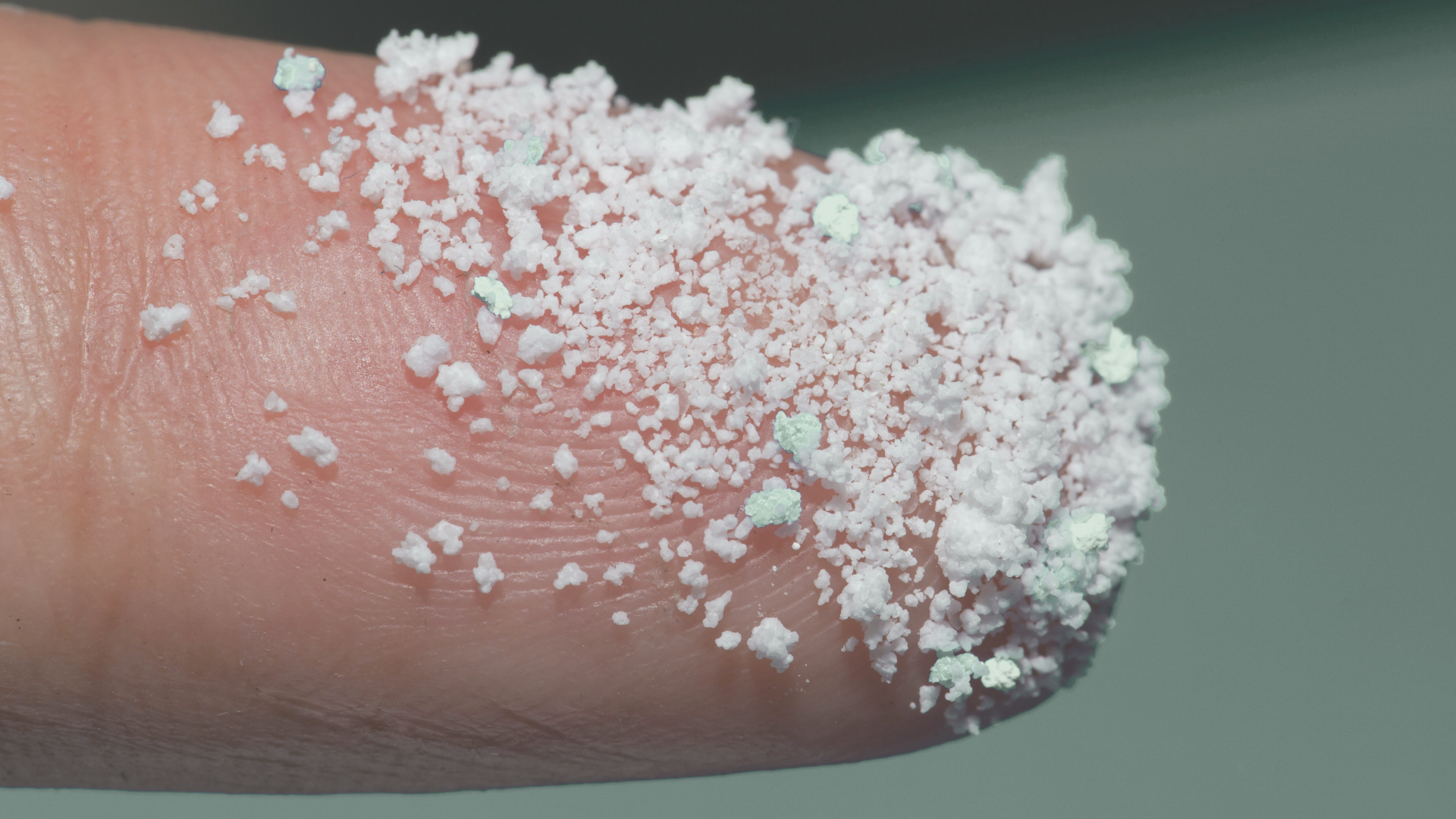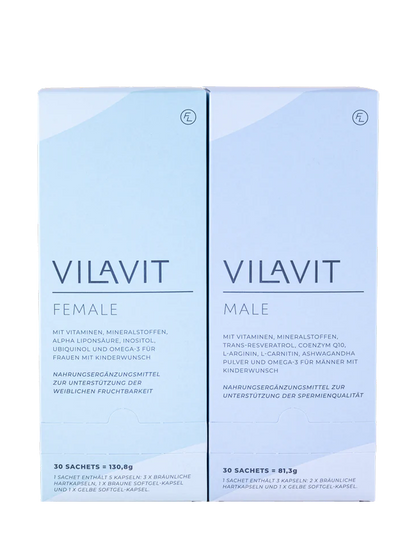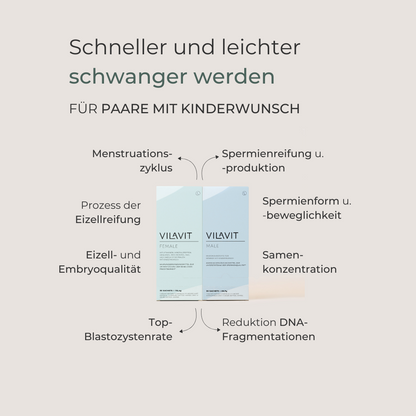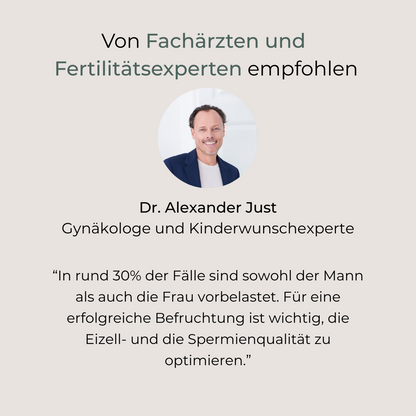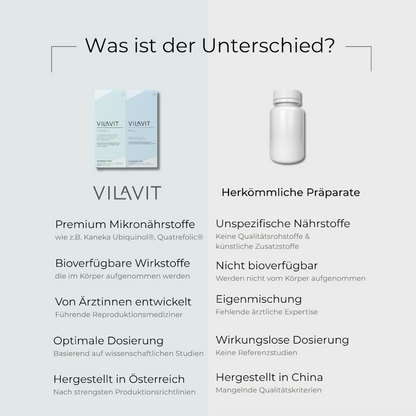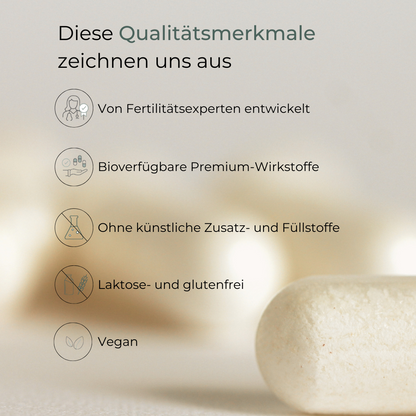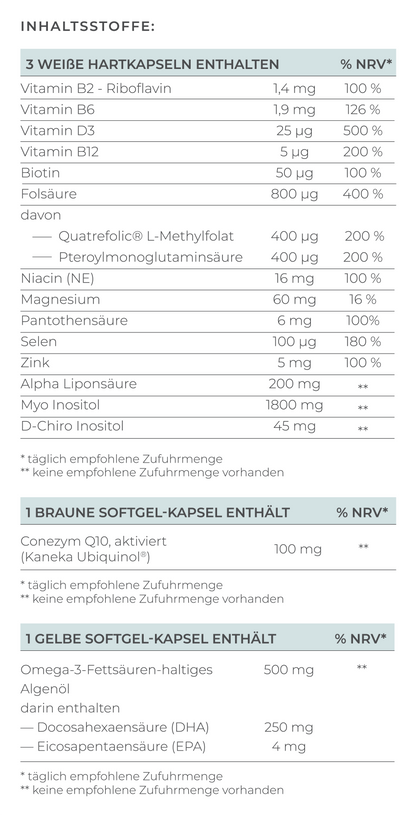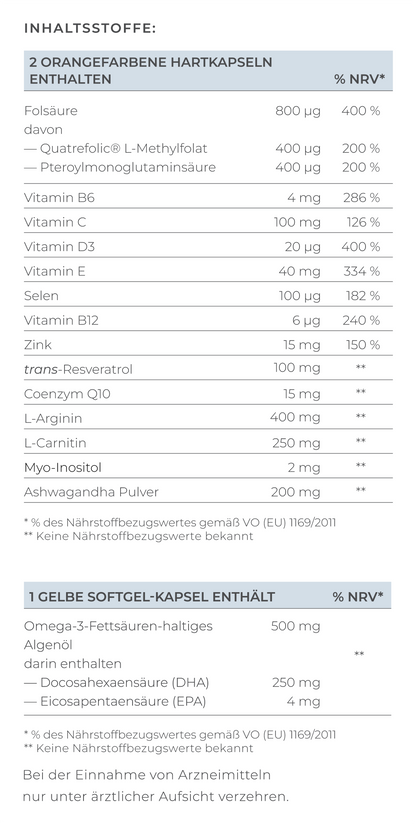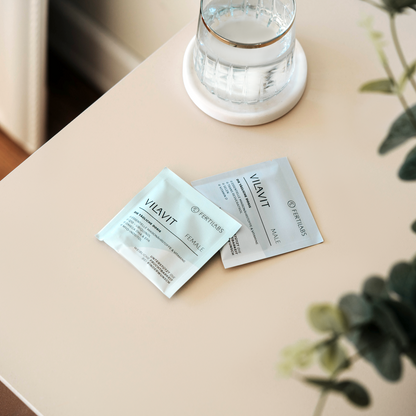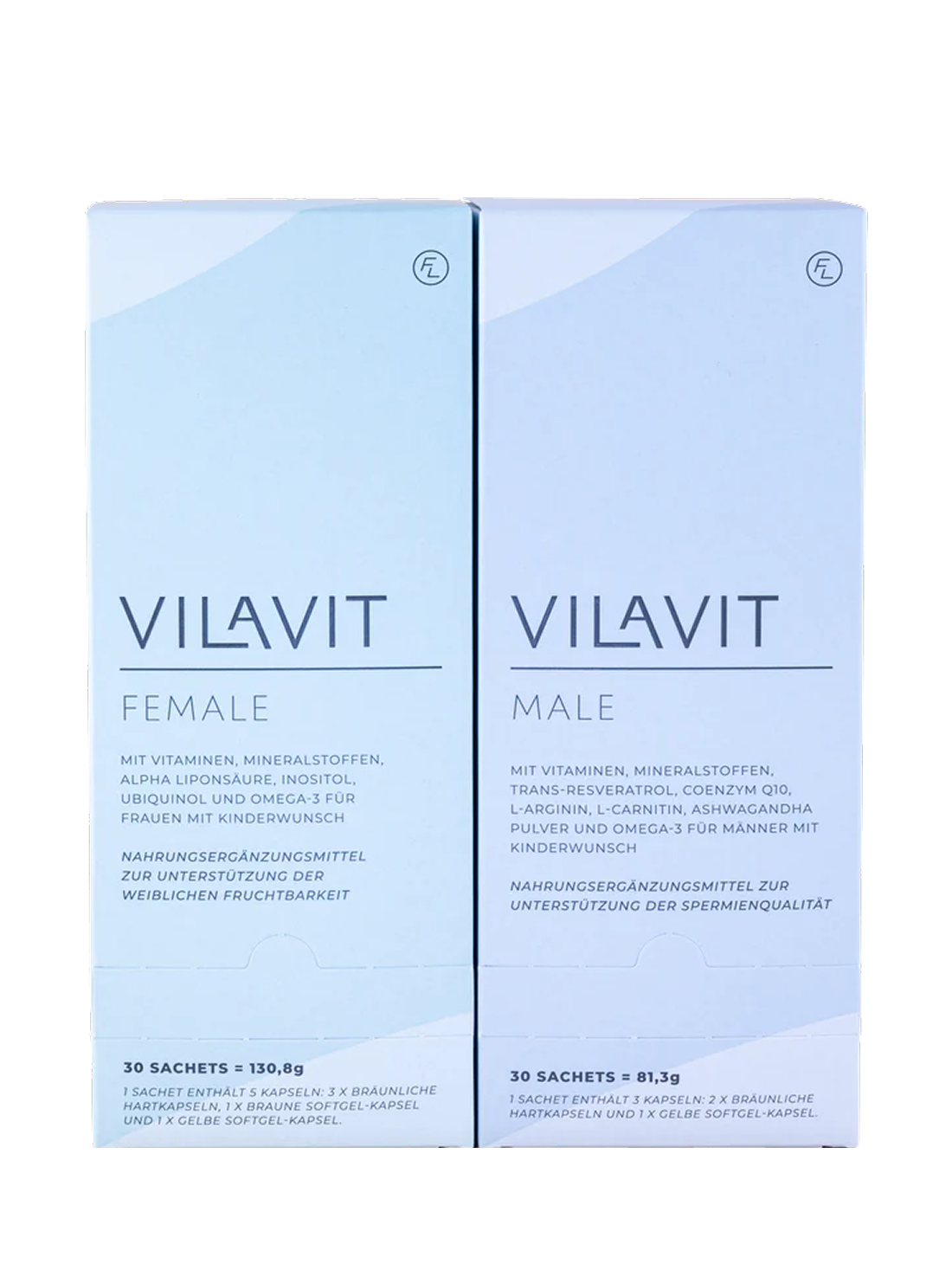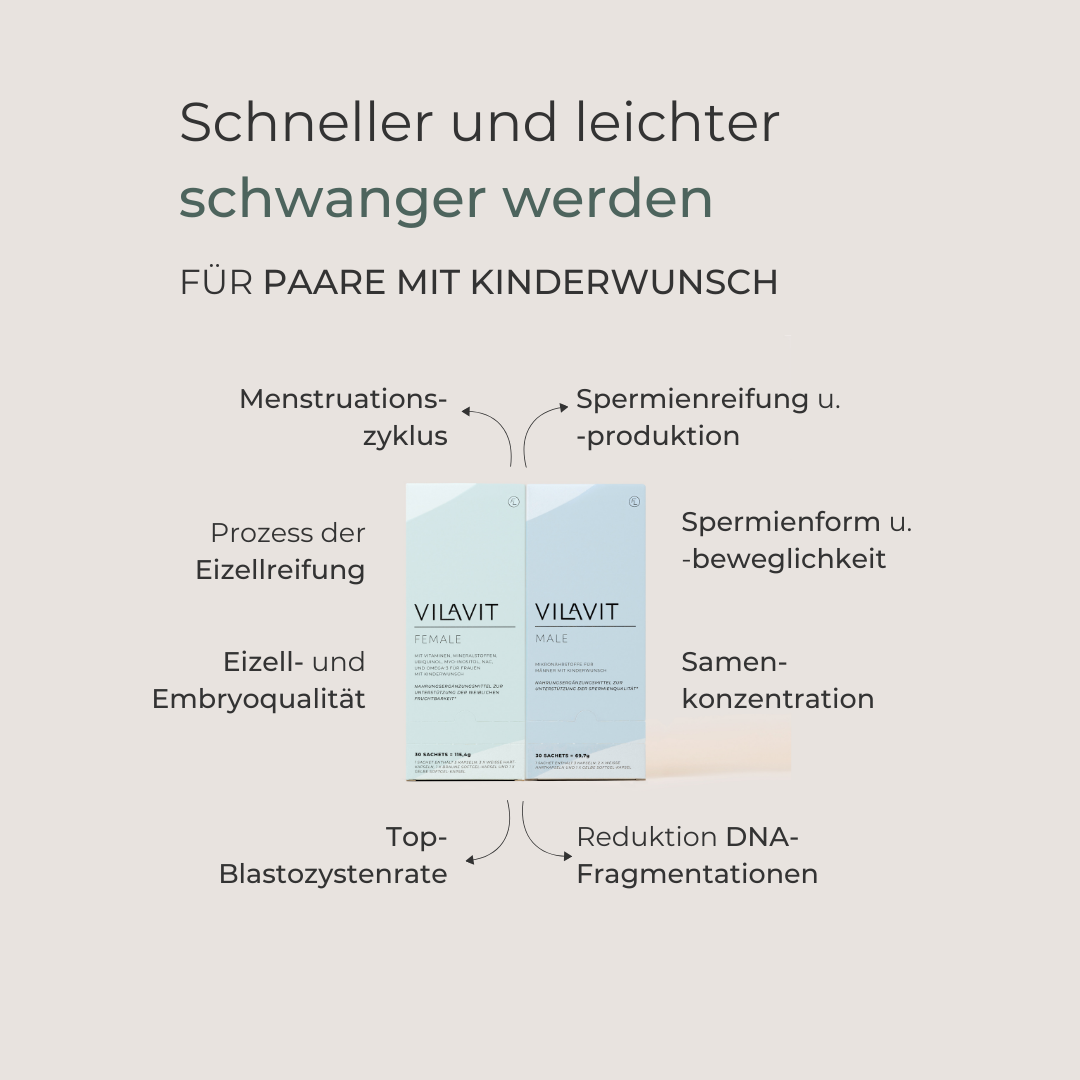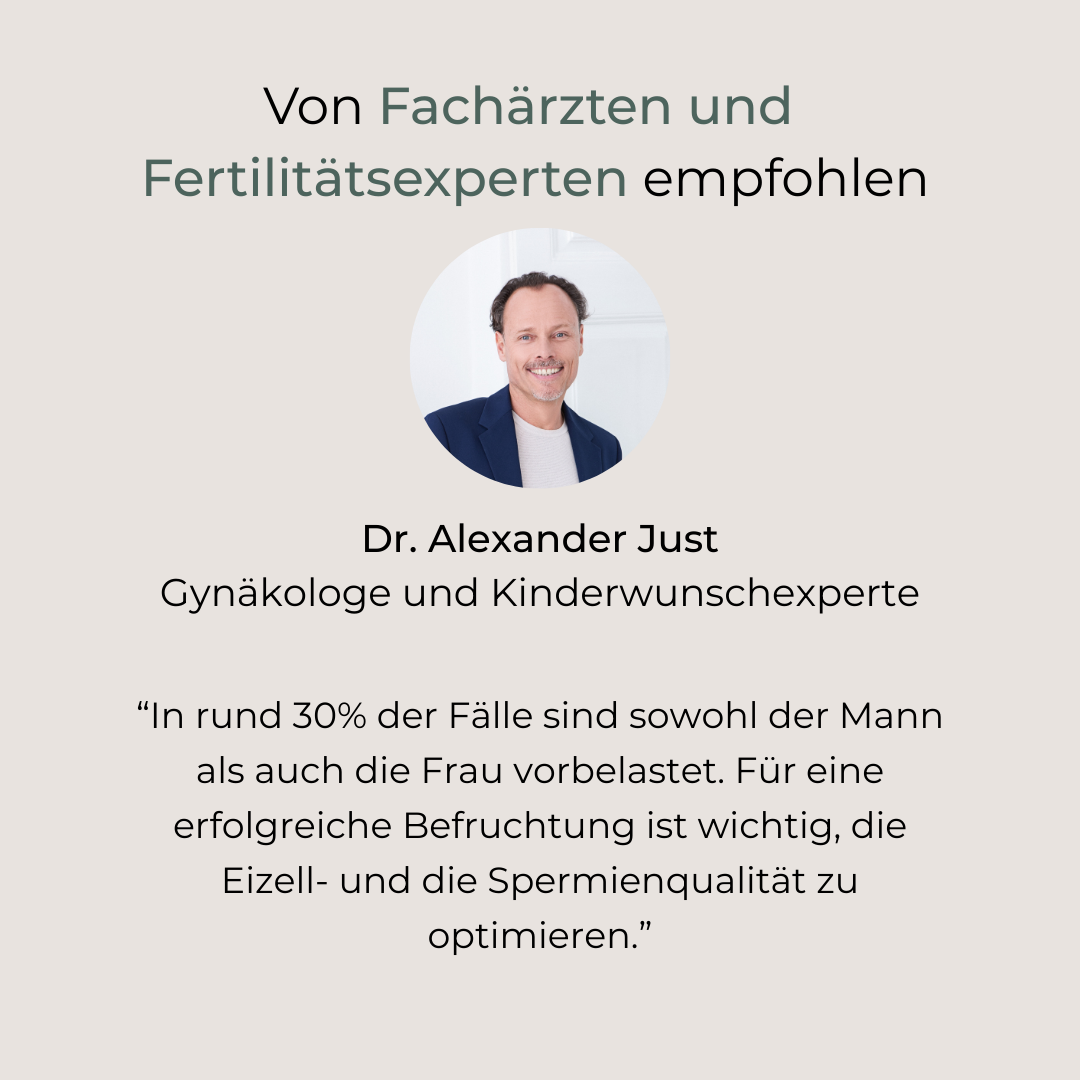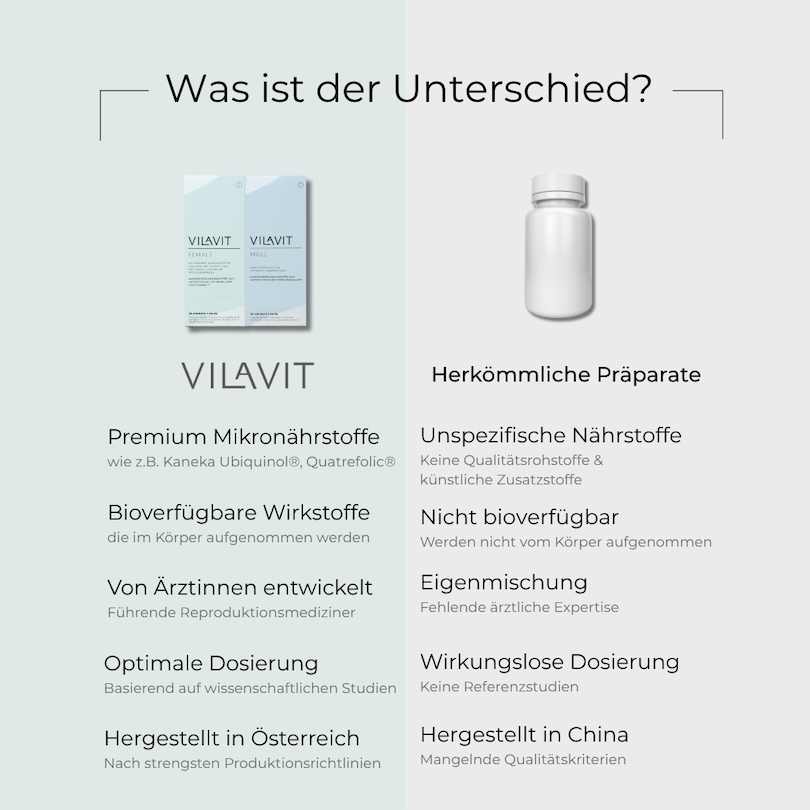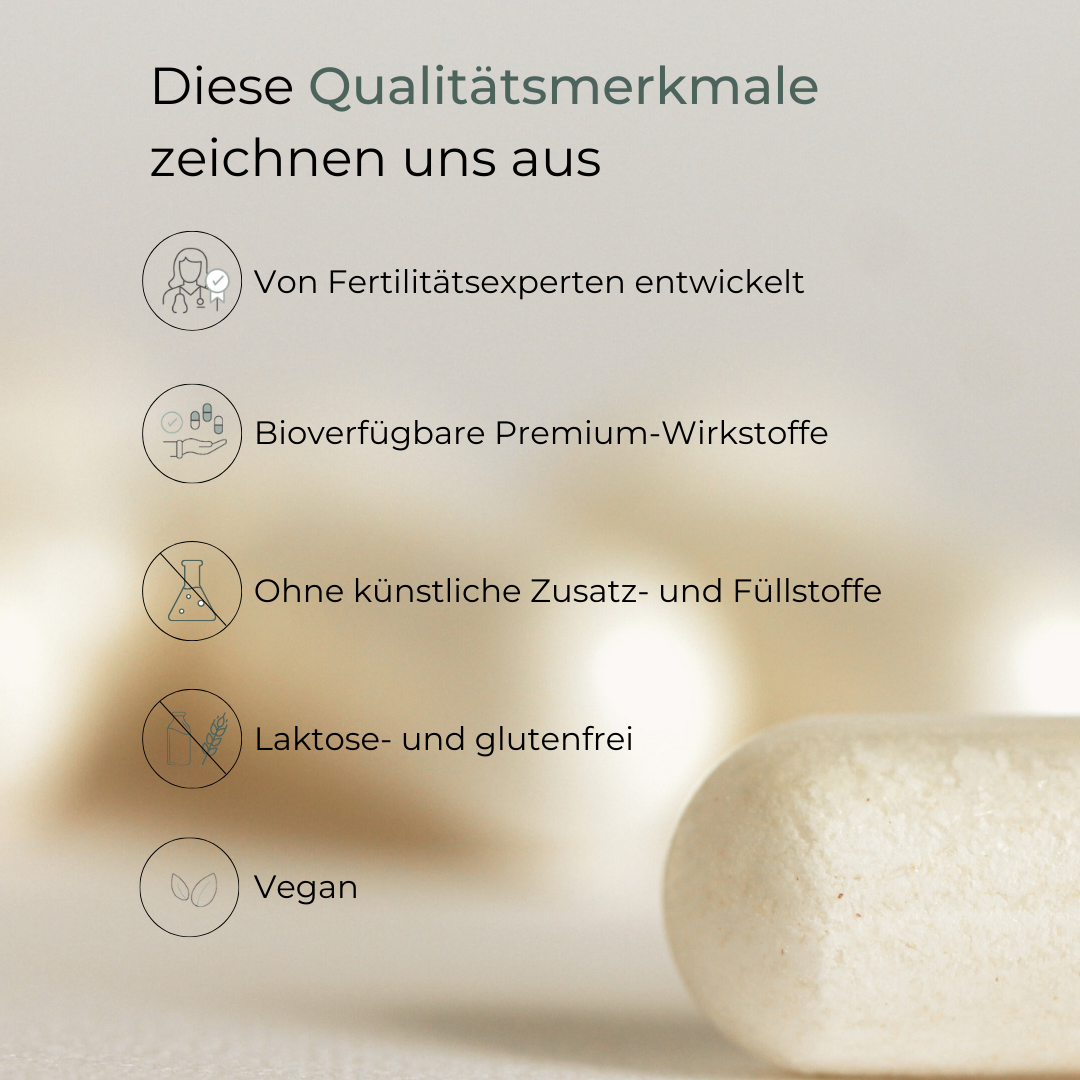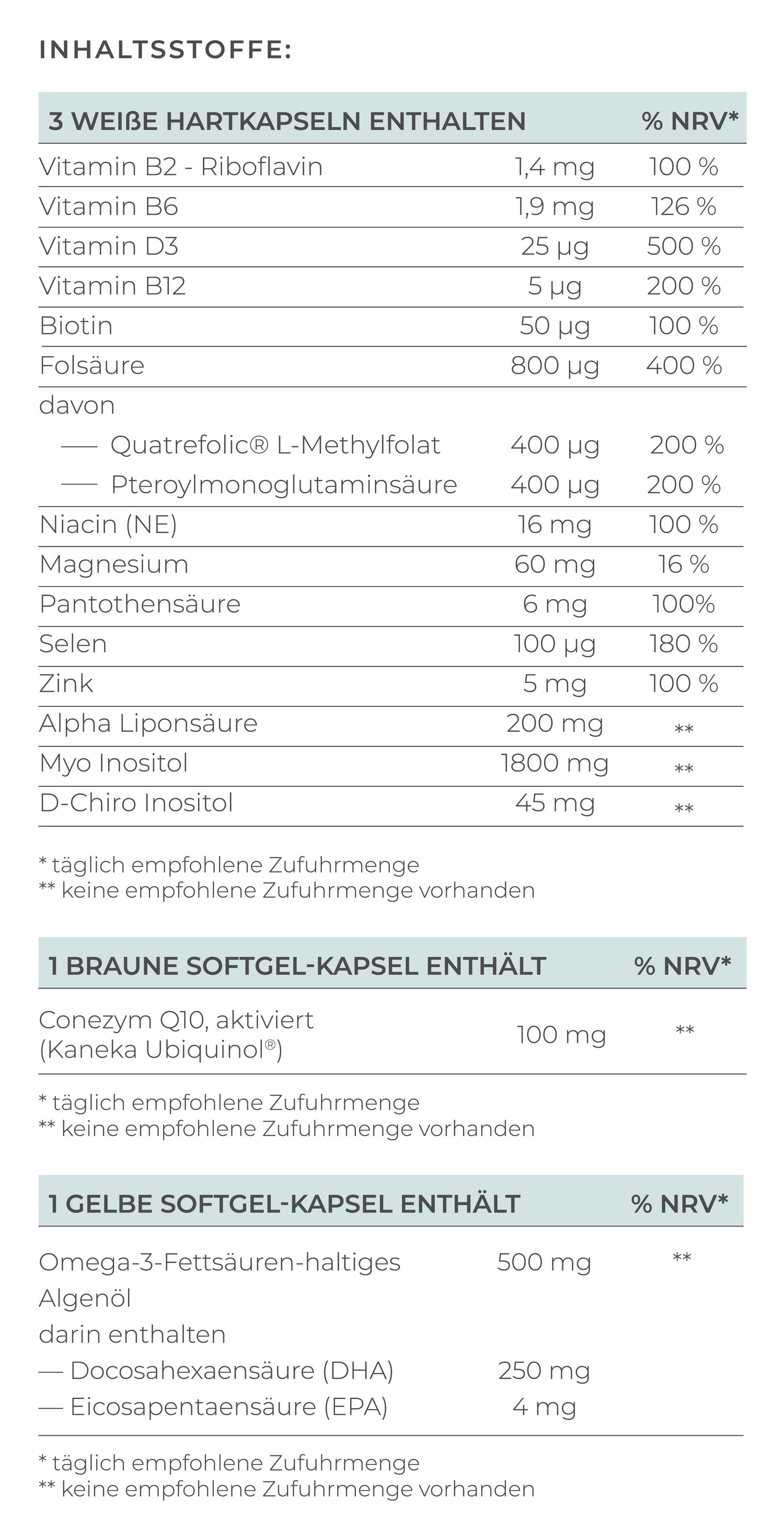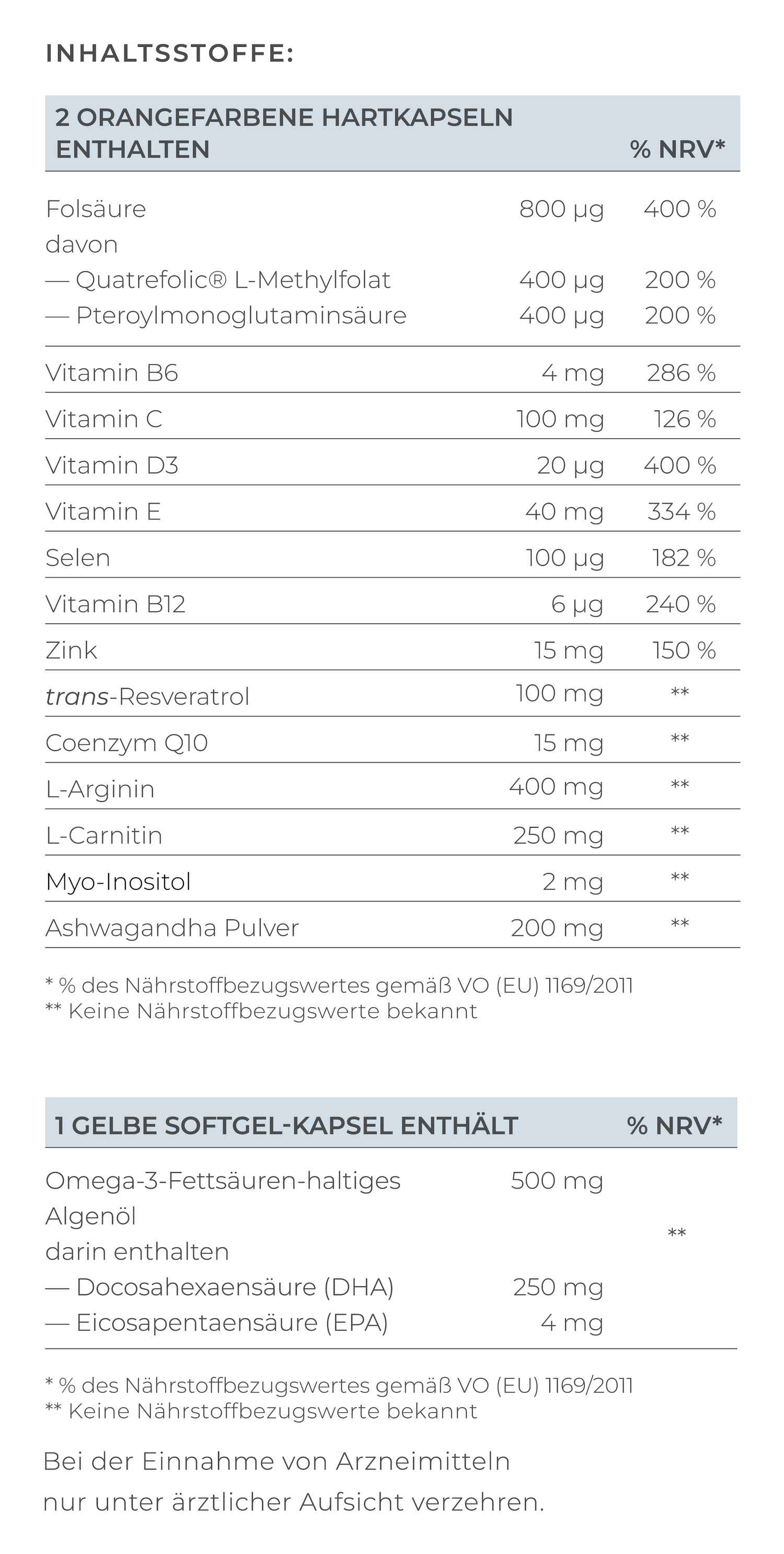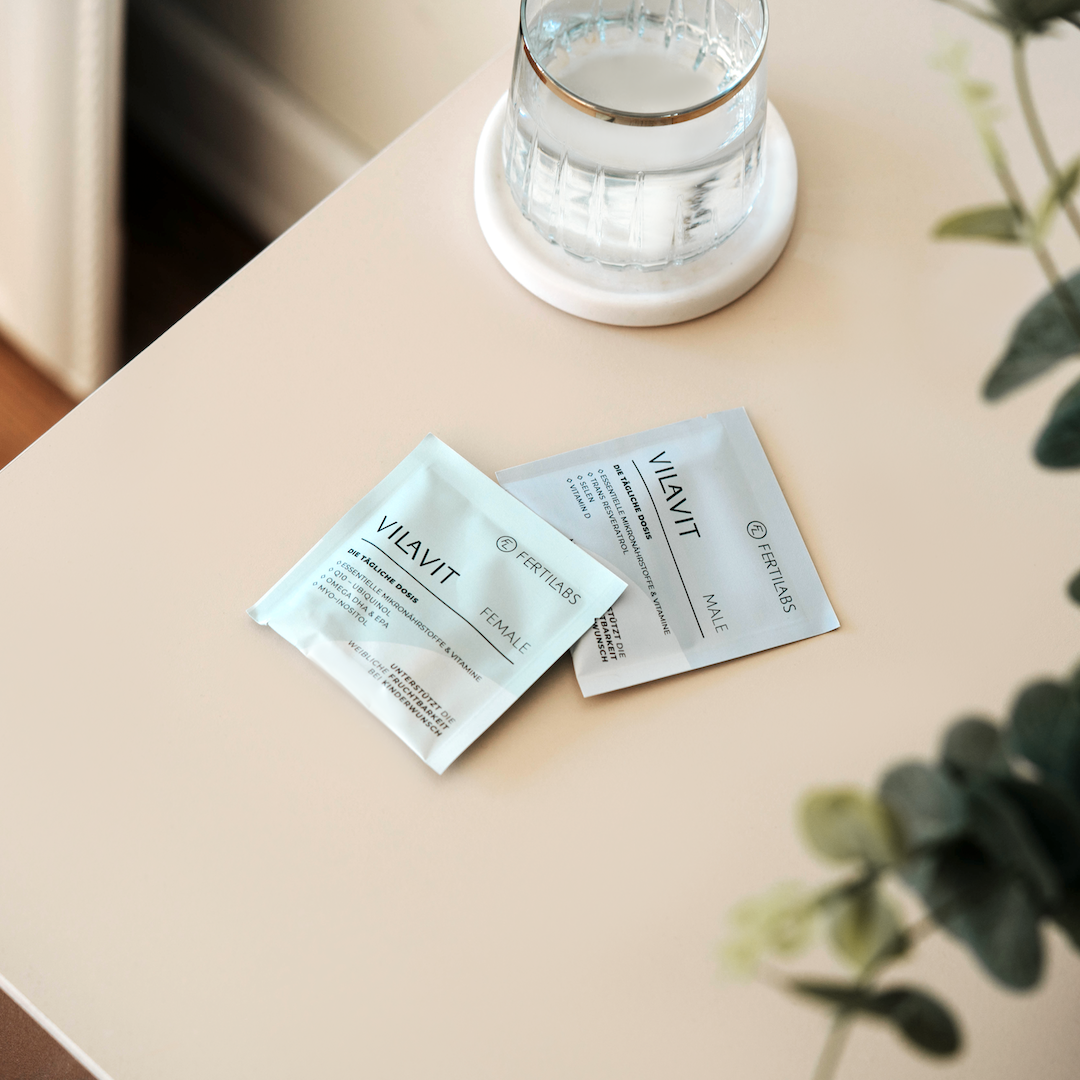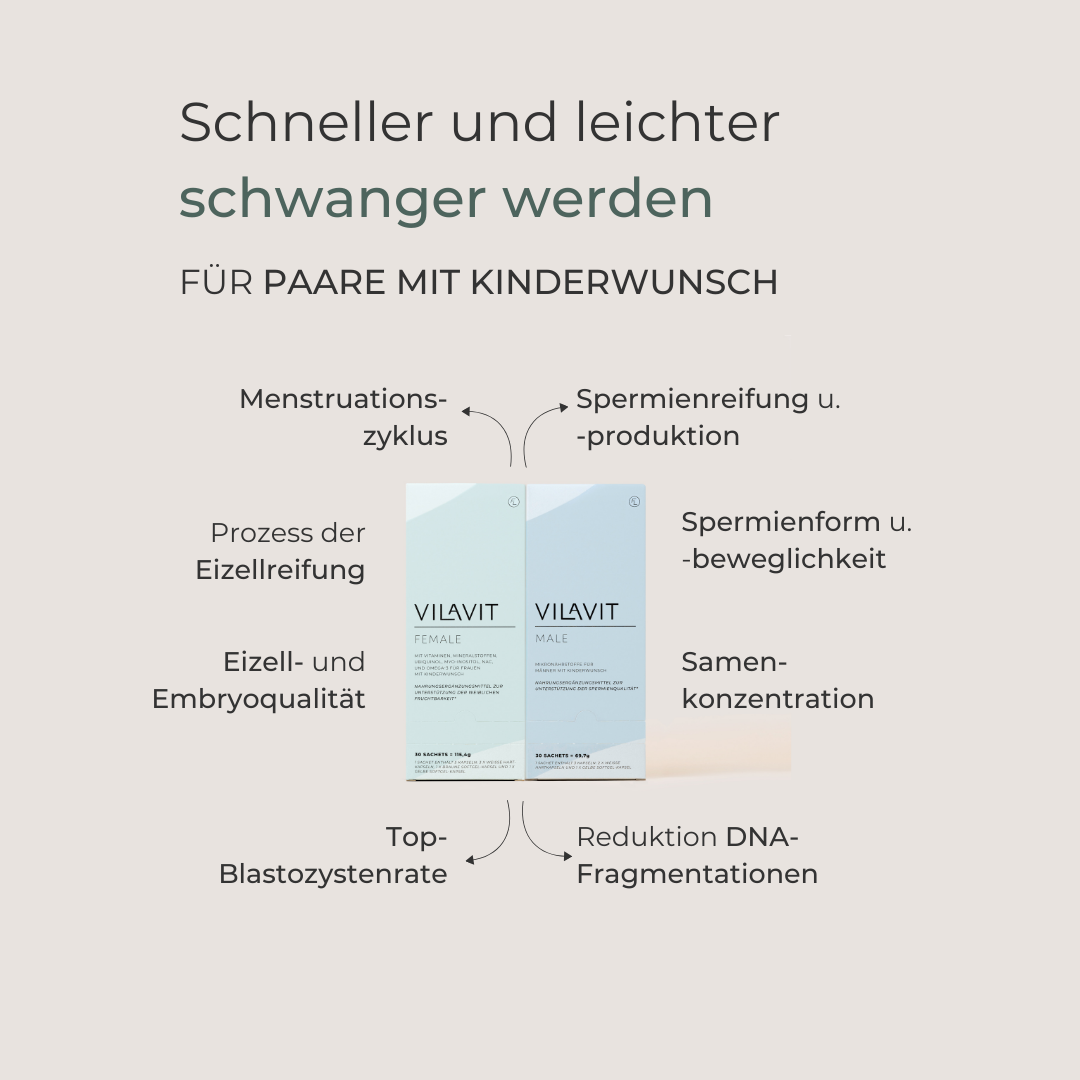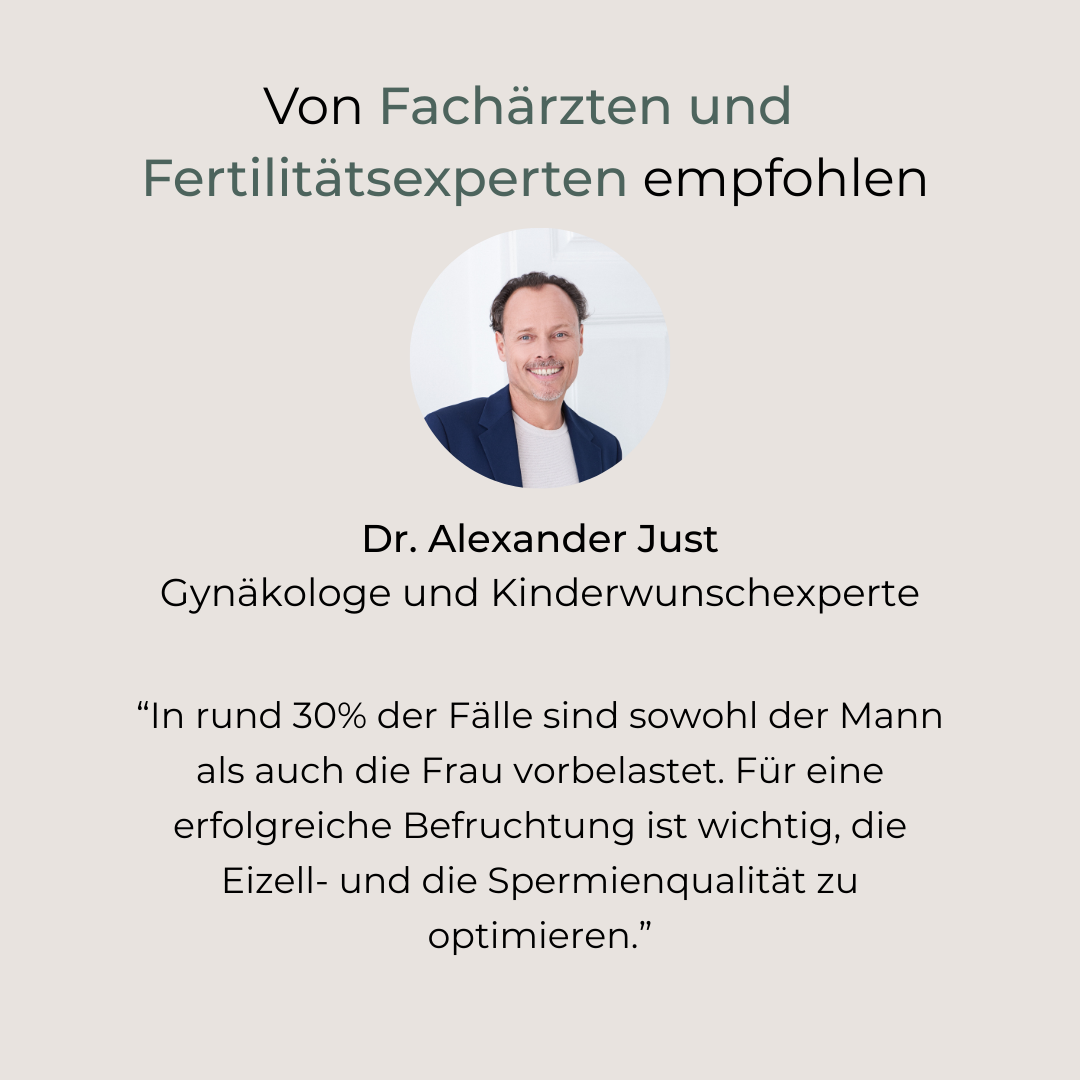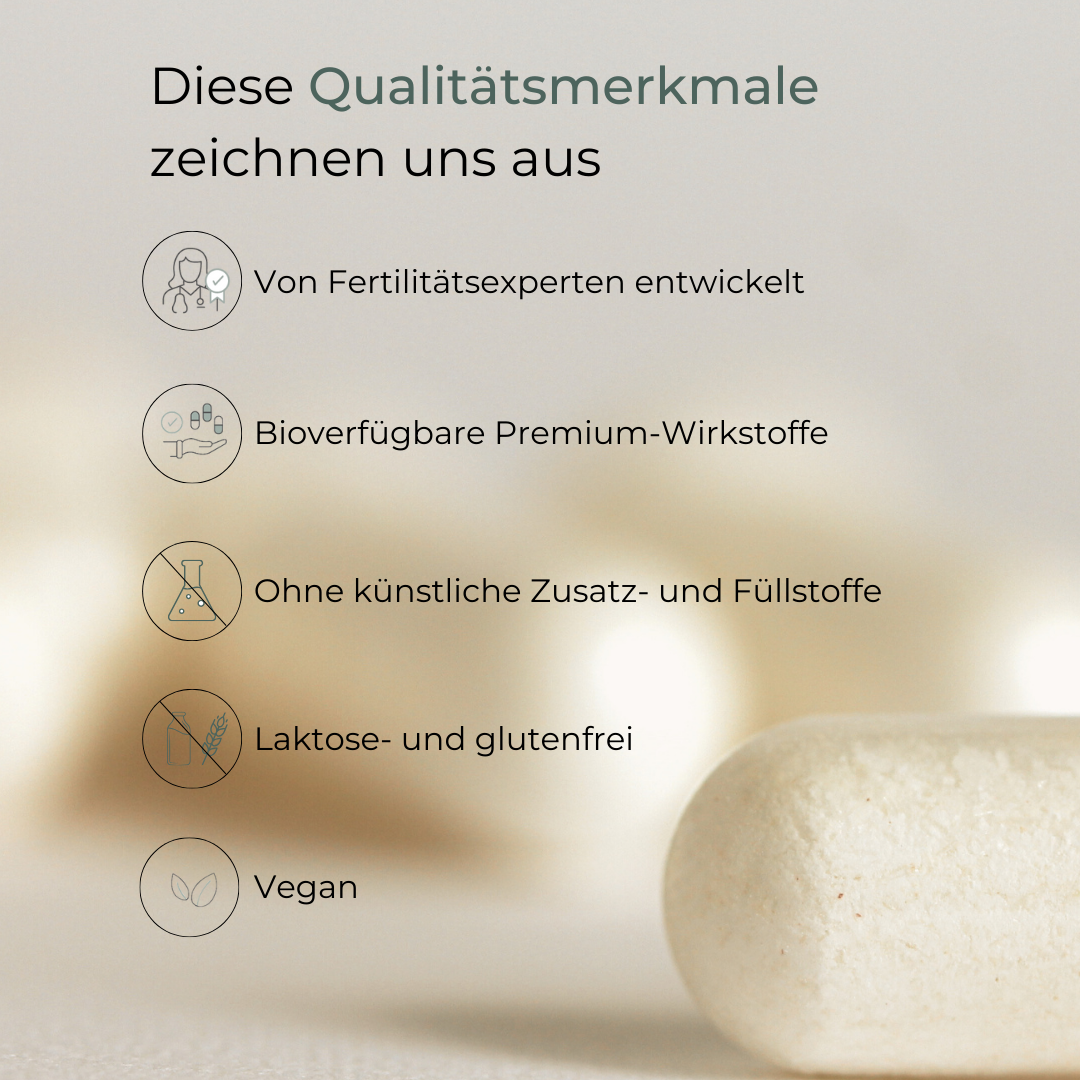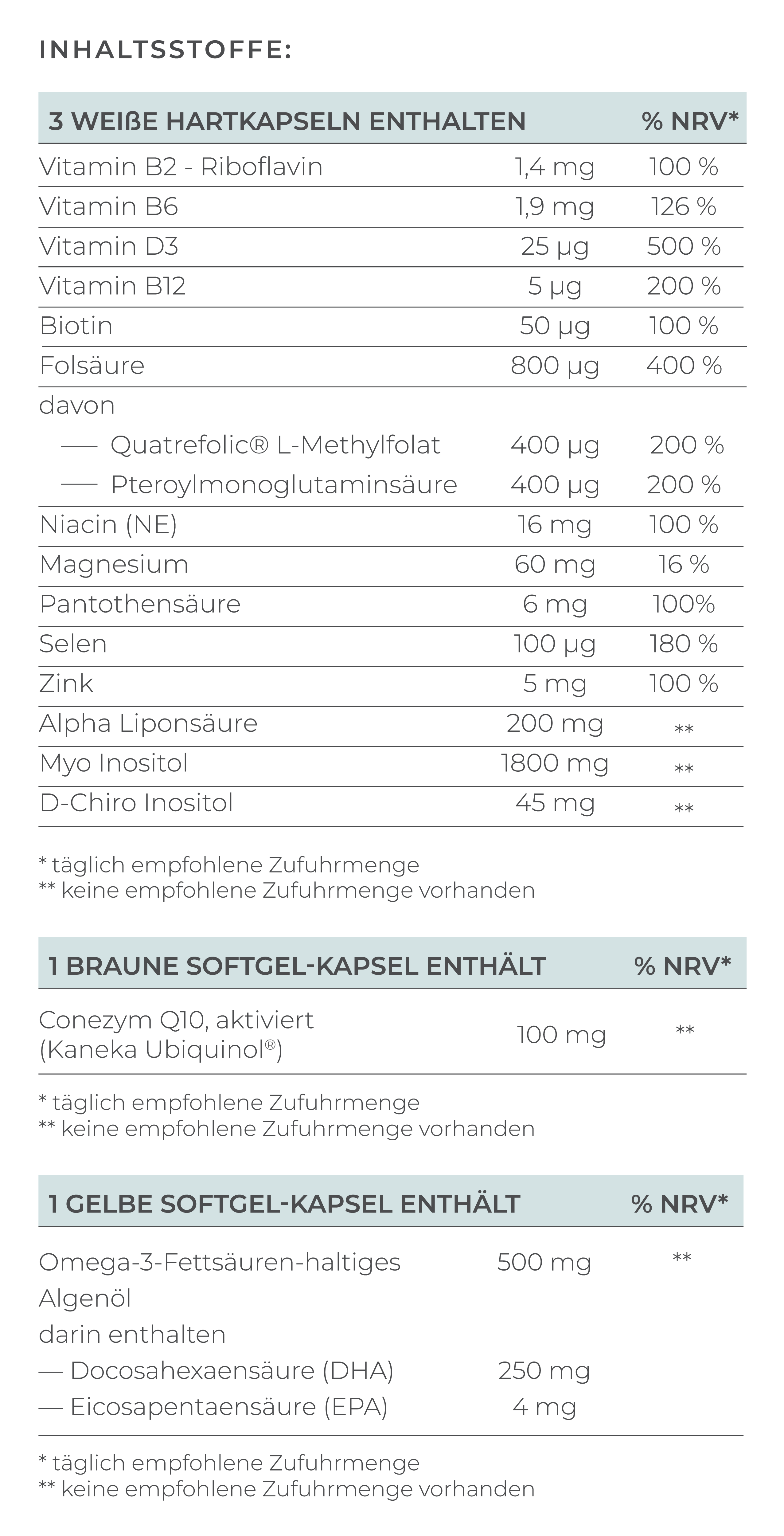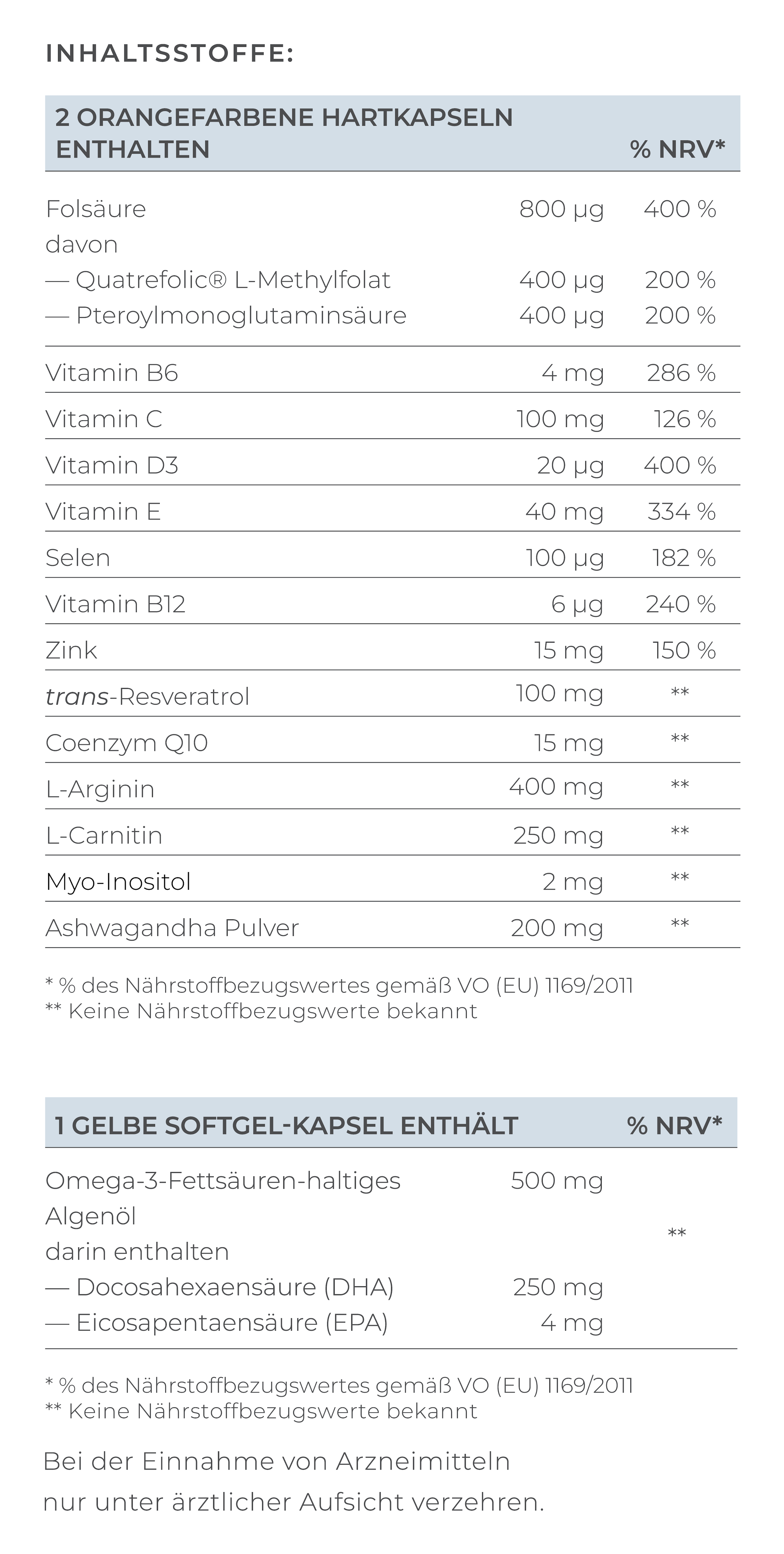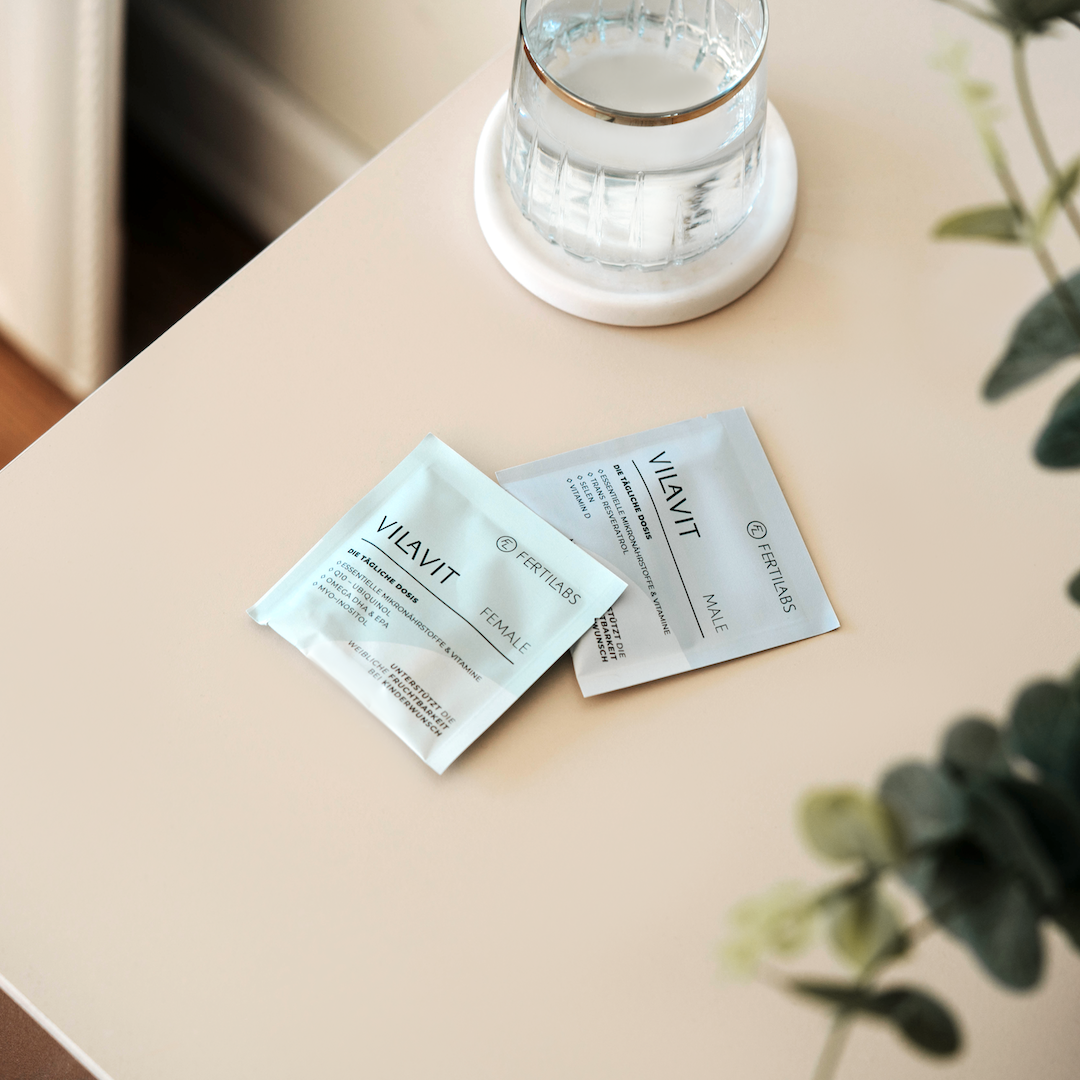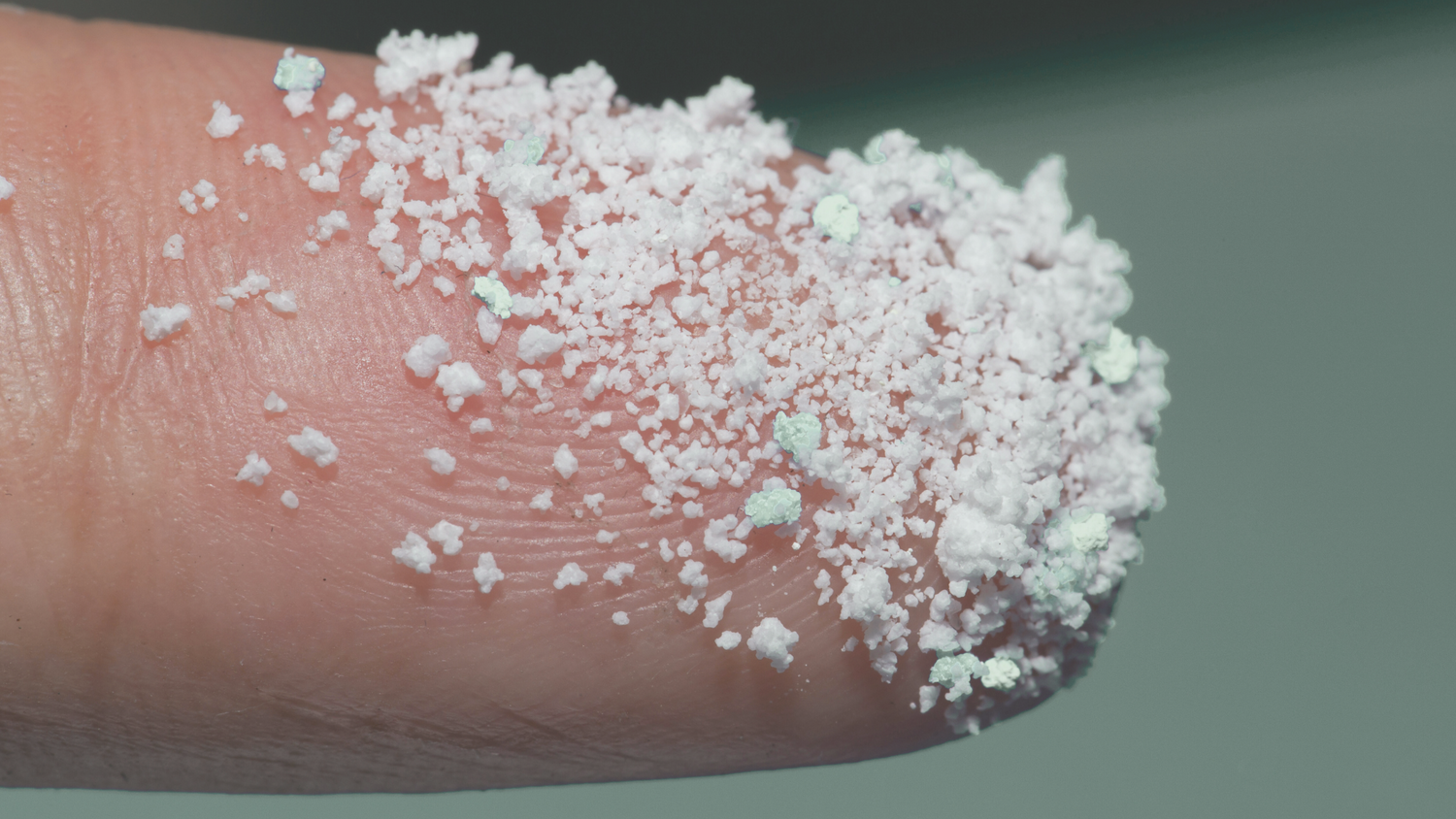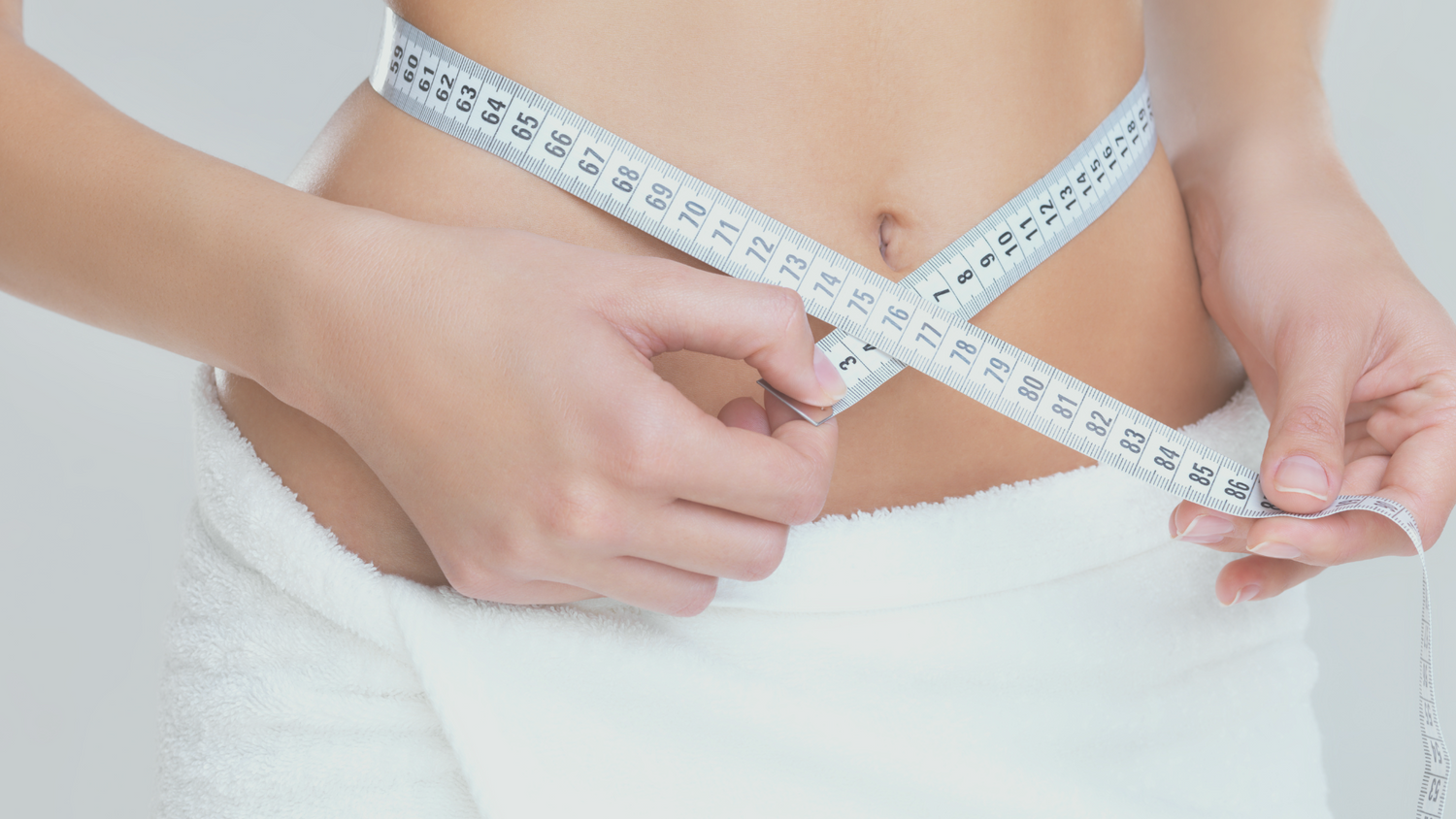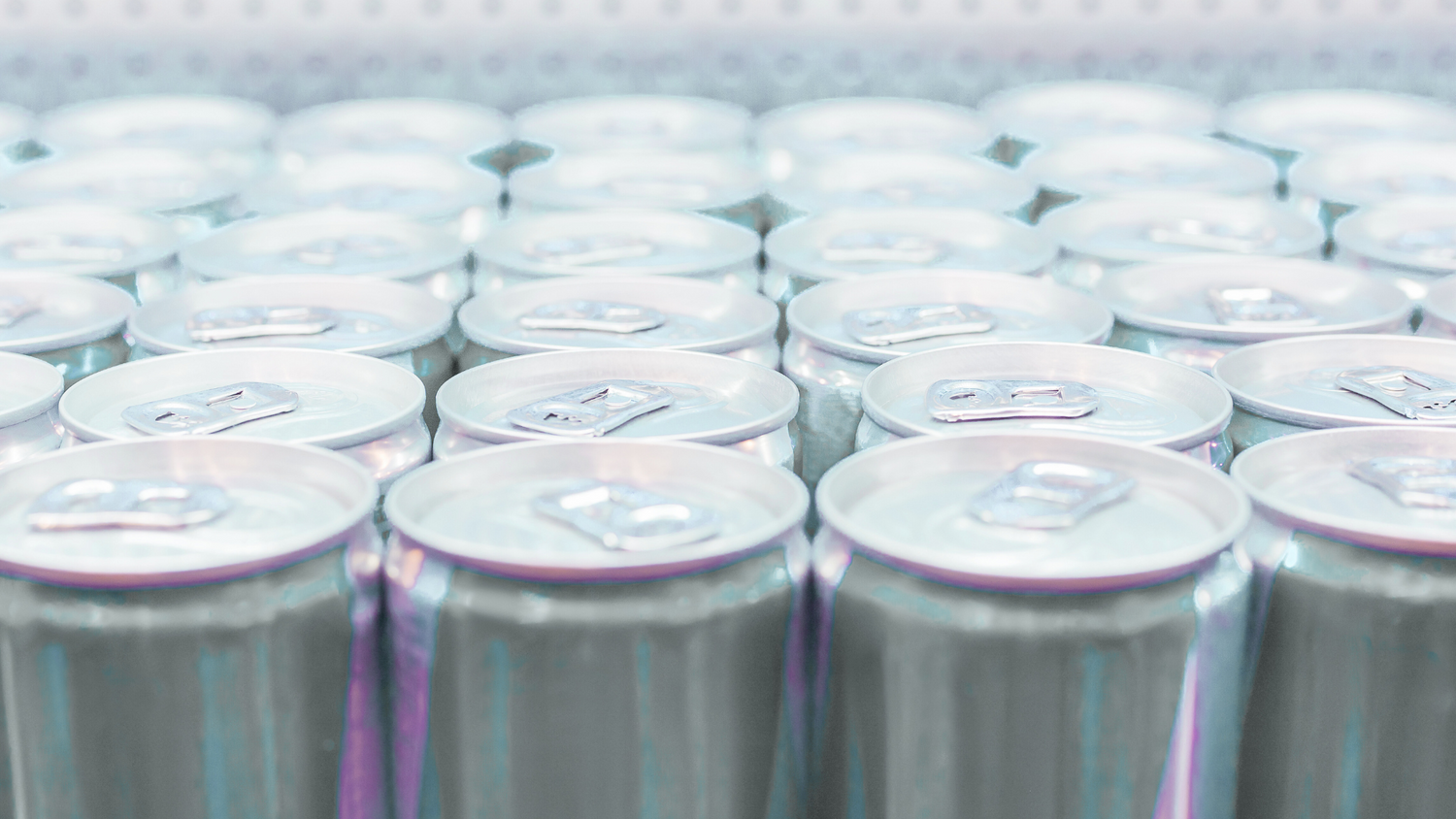The danger of microplastics to our planet is now well known and feared. However, it is often overlooked that microplastics can also directly harm us humans. In particular, the effects of microplastics on fertility are often underestimated or completely unknown. Here you can find out exactly how microplastics can affect your fertility and pregnancy and how you can reduce your exposure to microplastics.
What are microplastics and how do they get into our bodies?
Most people are aware that microplastics are small, lightweight pieces of plastic that are hardly biodegradable. But how small are microplastics exactly that we don't even notice them – even though they are in our bodies? Microplastics are between 1 μm and 5 mm in size. 1 μm corresponds to 0.001 mm and is no longer visible to the naked eye. For comparison: human hair is between 50 and 100 μm thick – up to 100,000 times larger than microplastics!
Since microplastics are truly tiny, they find various ways to enter the human body. The three most important routes that have been discovered so far are through inhalation, ingestion with food or drinks, or through the skin due to cosmetic products or clothing made of synthetic fibers (Winiarska, E., et al., 2024).
In addition to microplastics, there are also nanoplastics, which are even smaller plastic particles that enter the body in a similar way and have a similar effect. In many studies, it is simply not possible to completely separate the effects of microplastics and nanoplastics. For this reason, we will also present studies in which nanoplastics and microplastics have been investigated together.
Effects of microplastics on the body in general
Over the course of our lives, a frightening amount of microplastics is likely to accumulate in our bodies. This can lead to a variety of health problems: respiratory diseases such as asthma or lung cancer, neurological disorders such as exhaustion or dizziness can be caused by microplastics. Inflammatory bowel diseases and a disturbed gut microbiome can also occur (Winiarska, E., et al., 2024). Some scientists even describe microplastics as “immunotoxic,” as initial studies show that immune cells can be damaged by microplastics (Hirt, N., et al., 2020). Microplastics also appear to contribute to excessive apoptosis and necrosis, i.e., cell death. Inflammation and oxidative stress can also be promoted by microplastics (Yee, M., S., et al., 2021).
The effects of microplastics on female fertility
Microplastics and nanoplastics that accumulate in the female body appear to alter the structure of the uterus, ovaries, and other parts of the female reproductive system. In addition, the plastic particles can alter the secretion and metabolism of sex hormones, thereby damaging the hormonal balance necessary for a regular and well-functioning cycle. Women's reproductive age can also increase through contact with microplastics, thereby reducing fertility. The study authors also point out that the effects of microplastics could even be irreversible (Balali H., et al., 2024).
Furthermore, studies show that the intake of microplastics and nanoplastics also has an impact on the digestive system and can lead to lower food and energy intake. According to some studies, this lower energy intake appears to lead to the female reproductive system being undersupplied and thus impaired in its function (Geng, Y., et al., 2023).
Microplastics also increase oxidative stress in the body. Among other things, oxidative stress leads to increased apoptosis (cell death) and inflammation. Initial studies suggest that this oxidative stress can reduce fertility. Nanoplastics could also cause genes responsible for the production of antioxidant enzymes to contribute less frequently to the actual production of antioxidant substances, thereby further increasing oxidative stress in the body (Geng, V., et al., 2023).
Animal studies show that microplastics also accumulate in the ovaries over the long term, leading to a reduced egg reserve and ovarian volume, as well as a disrupted estrous cycle (essentially the animal menstrual cycle). Microplastics are also frequently found in the uterus, where they can lead to a thinner endometrium (mucous layer) and other pathological changes (Geng, Y., et al., 2023).
It remains to be seen whether and how exactly the effects of microplastics and nanoplastics in the human body differ from those in animals. However, past experience shows that at least similar results can usually be expected.
However, it is clear that microplastics have already been detected in women's follicular fluid. This fluid surrounds the egg cells during maturation, supporting and supplying them with hormones, enzymes, nutrients, and other molecules. However, according to scientists, possibly due to the small sample size, no clear link between microplastic concentration in follicular fluid and fertilization, miscarriage, and live birth rates has been established to date. However, a link between microplastic levels and FSH levels has been demonstrated (Montano, L., et al., 2025).
The effects of microplastics on male fertility
Data show that the plasticizer BPA, which may also be present in microplastics, is associated with reduced male fertility. BPA appears to negatively affect spermatogenesis, the production of sex hormones, sperm quality, the blood-testis barrier, and gene regulation. In addition, BPA promotes the death of germ cells and Sertoli cells, both of which are essential for male fertility and sperm production. Several human studies have shown that higher BPA levels in urine are more common in men with abnormal sperm and reduced fertility (D'Angelo, S., et al., 2021).
A study involving mice also found that mice exposed to higher levels of microplastics had reduced sperm count and quality. As the study progressed, altered sperm production and increased inflammation levels were observed. Alarmingly, after some time, researchers were also able to detect microplastics in the Sertoli and Leydig cells of the mice (D'Angelo, S., et al., 2021). Both cell types are essential for spermatogenesis.
Based on the knowledge that DNA fragmentation (DNA damage) in sperm leads to reduced fertility, a study was conducted with rats. It was found that rats that had more contact with microplastics also had more DNA fragmentation (Zhang, C., et al., 2022).
One of the largest human studies on this topic to date, involving over 100 participants, showed that the number of sperm present and sperm concentration are impaired by contact with microplastics. In particular, the plastic polytetrafluoroethylene, PTFE, marketed under the brand name Teflon®, appears to cause a significant reduction in sperm motility and concentration. However, the total number of sperm was also reduced by increased PTFE exposure. Alarmingly, the scientists also reported that each additional exposure to microplastics increased the risk of a reduction in sperm concentration by a factor of 3.22 (Zhang, C., et al., 2024).
The effects of microplastics on pregnancy
Unfortunately, it is now clear that microplastics and nanoplastics are already present in the uterus of some women. Studies in mice have shown that mice with microplastics or nanoplastics in their uterus have a smaller placenta, fewer cells with glycogen in the placenta, and poorly developed feto-placental vessels. Certain vessels that ensure blood flow to the uterus were also altered in these mice, as were certain metabolic processes.
In humans, microplastics and nanoplastics have been found in both the maternal and fetal parts of the uterus. It has been found that cells that come into contact with microplastics are more likely to show damage and abnormalities.
Initial studies—in both mice and humans—suggest that the birth weight, size, and head circumference of babies decrease the more contact the offspring have had with microplastics. However, it should be noted that not many studies have been published on the subject of microplastics and pregnancy, so it remains to be seen (Zurub, R. E., 2024).
Where do microplastics come from and how can I reduce my microplastic intake?
Microplastics can basically be produced from any plastic material and therefore also from any plastic object or product that we encounter in everyday life. Due to the advantages of plastic, such as its low weight and price, it is almost impossible to avoid plastic completely.
Sources that are difficult or impossible to avoid
Some sources of microplastics can hardly or not at all be prevented or avoided as an individual. These include, for example, the intake of microplastics through the air—both indoors and outdoors. Microplastics are produced there, for example, by industry and construction work. But waste incineration, clothing, and traffic also contribute to the release of microplastics into the air around us (Zuri, G., et al., 2023).
Microplastics in food
One source that you, as an individual, can at least influence to some extent is your diet. Depending on the source, consuming seafood, fish, and other aquatic life can result in ingesting a significant amount of microplastics. This is because lakes, rivers, and oceans contain high levels of microplastics, which are ingested by the animals and organisms that live there—much like microplastics in the air affect us.
Microplastics have also been detected in beverages, and while you should of course continue to drink enough fluids, there are a few small tricks you can use to reduce your intake of microplastics: Tap water usually contains the least amount of microplastics and should preferably not be drunk from plastic bottles or other plastic containers – this includes both reusable and disposable bottles from the supermarket or filled at home. We recommend glass or metal bottles as alternatives. However, the study authors point out that bottle caps have a significant impact on microplastic intake. You can therefore also make sure that the cap or mouthpiece of your bottle does not contain plastic (Zuri, G., et al., 2023).
Tea bags made of plastic can also release unnecessarily high amounts of plastic and should therefore be avoided (Doroftei, B., et al., 2025).
The extent to which other foods contribute to your microplastic consumption is still relatively unknown, but we assume that using less plastic packaging is certainly not a bad idea.
Microplastic absorption through the skin
Microplastics can enter the body through our skin. This can happen through sunscreen, makeup, or deodorants, for example (Doroftei, B., et al., 2025). Microplastics can be avoided, especially in cosmetic products, and this could be a starting point for your efforts to reduce plastic consumption.
Microplastics in everyday objects
Microplastics are also found in many everyday objects, such as textiles made from synthetic fibers. Microplastics are released particularly during washing or other abrasion. Therefore, it may be advisable to avoid clothing made from polyester or microfiber cleaning cloths. Plastic cooking utensils can also contribute to increased microplastic pollution via food. Pans without plastic coatings, wooden boards, and other kitchen utensils such as spatulas or kettles made of metal or wood can reduce your exposure.
Microplastics in hygiene products
Unfortunately, feminine hygiene products are also a source of microplastics and pose a risk that should not be underestimated, especially for women who want to have children, as the microplastics end up in close proximity to the reproductive organs. For example, one study showed that a single tampon releases up to 17 billion nanoplastics particles (Doroftei, B., et al., 2025)! This is an unimaginable burden, especially since several tampons are used (and must be used) per menstrual cycle. Unfortunately, there is no reliable data available for other hygiene products such as pads, cups, or period underwear. Therefore, we can only advise you to be mindful and do your own research. Some manufacturers promise to do without microplastics and nanoplastics – in most cases, the price of these products is slightly higher than that of conventional products.
Frequently asked questions on the topic
What are microplastics?
Microplastics are tiny plastic particles that are created when larger plastic products break down. They cannot currently be broken down and are entering the human body in ever-increasing quantities.
How do microplastics enter the body?
Microplastics often enter the body via the gastrointestinal tract or the respiratory tract – i.e. through food or the air we breathe. However, microplastics are also released through skin contact with cosmetics or hygiene products such as tampons.
What effects do microplastics have on fertility?
Microplastics have various effects on fertility—in both men and women. Cells die off due to contact with microplastics, and hormone balance is disrupted. In addition, oxidative stress increases, and both sperm and egg cells are likely to decline in quality and number due to microplastics.
What effects do microplastics have on pregnancy?
Cell damage caused by microplastics is also a problem in relation to pregnancy. Overall, it has been found that microplastics in the uterus reduce blood flow to the uterus, and babies often have a lower birth weight, size, and head circumference.
How can I reduce my microplastic intake?
If possible, limit your consumption of seafood and fish and avoid plastic packaging wherever possible—especially plastic bottles for beverages. Plastic-free cooking utensils can be helpful when preparing food. You can also look for microplastic-free cosmetic products and avoid synthetic textiles. It is also advisable to use plastic-free alternatives for hygiene products such as tampons.
References
Winiarska, E., Jutel, M., & Zemelka-Wiacek, M. (2024). The potential impact of nano- and microplastics on human health: Understanding human health risks. Environmental research, 251(Pt 2), 118535.
Hirt, N., & Body-Malapel, M. (2020). Immunotoxicity and intestinal effects of nano- and microplastics: a review of the literature. Particle and fibre toxicology, 17(1), 57.
Yee, M. S., Hii, L. W., Looi, C. K., Lim, W. M., Wong, S. F., Kok, Y. Y., Tan, B. K., Wong, C. Y., & Leong, C. O. (2021). Impact of Microplastics and Nanoplastics on Human Health. Nanomaterials (Basel, Switzerland), 11(2), 496.
Zurub, R. E., Cariaco, Y., Wade, M. G., & Bainbridge, S. A. (2024). Microplastics exposure: implications for human fertility, pregnancy and child health. Frontiers in endocrinology, 14, 1330396.
D'Angelo, S., & Meccariello, R. (2021). Microplastics: A Threat for Male Fertility. International journal of environmental research and public health, 18(5), 2392.
Zhang, C., Zhang, G., Sun, K., Ren, J., Zhou, J., Liu, X., Lin, F., Yang, H., Cao, J., Nie, L., Zhang, P., Zhang, L., Wang, Z., Guo, H., Lin, X., Duan, S., Cao, J., & Huang, H. (2024). Association of mixed exposure to microplastics with sperm dysfunction: a multi-site study in China. EBioMedicine, 108, 105369.
Zhang, C., Chen, J., Ma, S., Sun, Z., & Wang, Z. (2022). Microplastics May Be a Significant Cause of Male Infertility. American journal of men's health, 16(3), 15579883221096549.
Balali, H., Morabbi, A., & Karimian, M. (2024). Concerning influences of micro/nano plastics on female reproductive health: focusing on cellular and molecular pathways from animal models to human studies. Reproductive biology and endocrinology : RB&E, 22(1), 141.
Geng, Y., Liu, Z., Hu, R., Huang, Y., Li, F., Ma, W., Wu, X., Dong, H., Song, K., Xu, X., Zhang, Z., & Song, Y. (2023). Toxicity of microplastics and nanoplastics: invisible killers of female fertility and offspring health. Frontiers in physiology, 14, 1254886.
Montano, L., Raimondo, S., Piscopo, M., Ricciardi, M., Guglielmino, A., Chamayou, S., Gentile, R., Gentile, M., Rapisarda, P., Oliveri Conti, G., Ferrante, M., & Motta, O. (2025). First evidence of microplastics in human ovarian follicular fluid: An emerging threat to female fertility. Ecotoxicology and environmental safety, 291, 117868.
Zuri, G., Karanasiou, A., & Lacorte, S. (2023). Microplastics: Human exposure assessment through air, water, and food. Environment international, 179, 108150.
Doroftei, B., Savuca, A., Cretu, A. M., Maftei, R., Anton, N., Ilea, C., Doroftei, M., & Puha, B. (2025). Microplastics and human fertility: A comprehensive review of their presence in human samples and reproductive implication. Ecotoxicology and environmental safety, 303, 118939.


